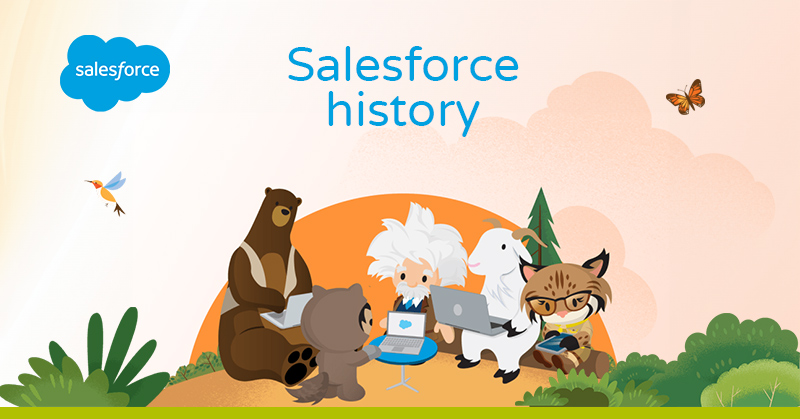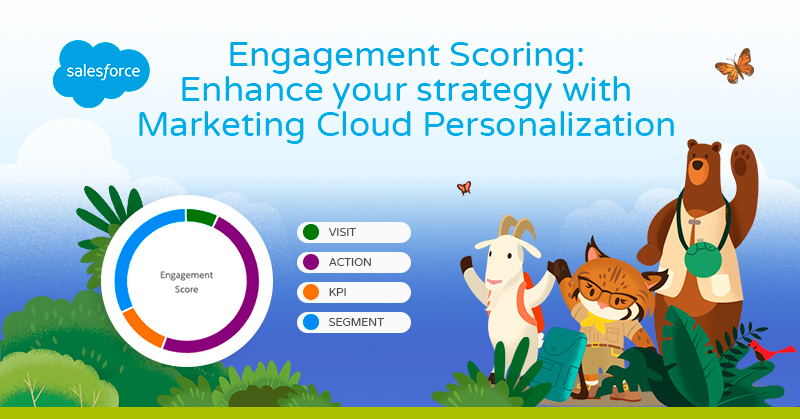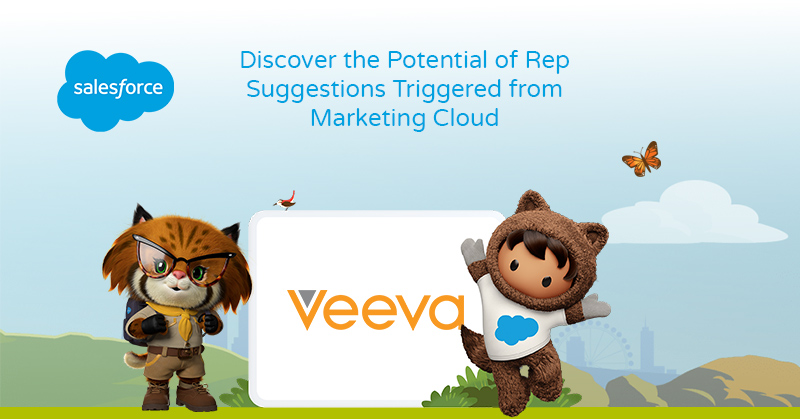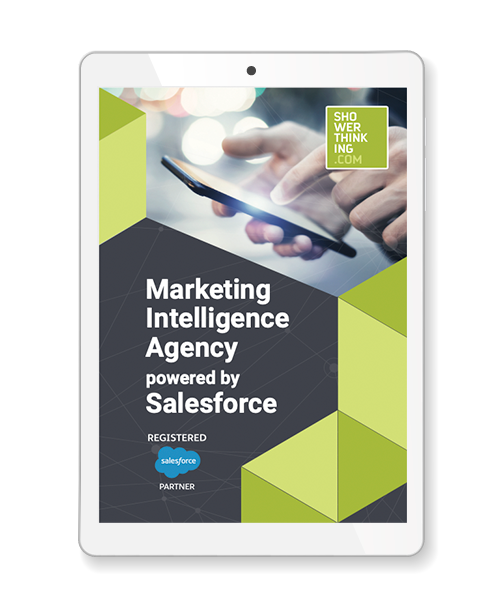Salesforce is a very young company that is in the middle of a “Boom”, however it has an interesting story worthy of a Hollywood movie script, ingredients are not lacking and above all we are facing the typical story of the American dream. If you still don’t know what Salesforce is, I invite you to read the article Discover what Salesforce is, much more than a CRM.
March 2019 marks the 20th anniversary of Salesforce’s founding, and in this article we summarize the most important milestones in the short life of a technology company that has managed to become the fastest to generate annual revenues in excess of $10 billion and that will surely also break the $20 billion record.
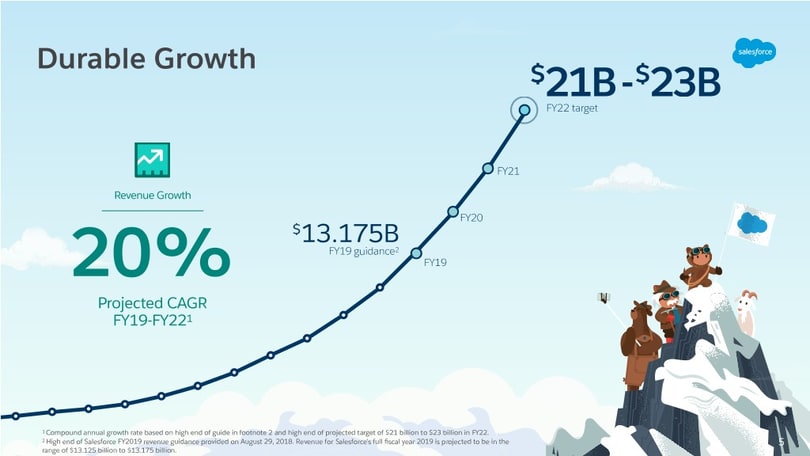
In 1999 a former Oracle manager creates a cloud-based CRM. It is easy to think today that Marc Benioff is a visionary who has been able to create a technological empire based on the cloud concept. However, if we look at the story of the Salesforce CEO, we really are looking at a “nutcase” who spent 13 years of his life working for Oracle and who.
When he became Vice President (the youngest in the company), gave up everything because of his obsession with developing business applications on a Software-as-a-Service business model.
Nowadays many startups take their first steps thanks to important financing rounds and investment groups but in 1999 things were a little different.
At that time Marc Benioff only had three fellow travelers: Parker Harris, Frank Dominguez and Dave Moellenhoff.
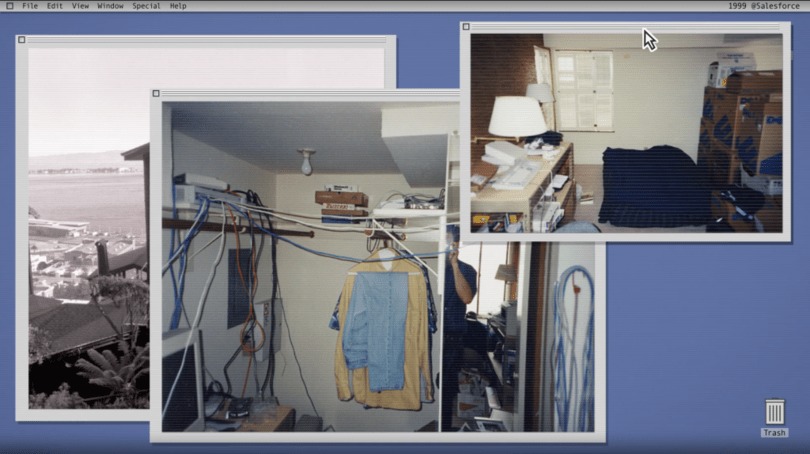
They decorated the room with posters of the Dalai Lama and Albert Einstein to find inspiration. Back then, the platform was far from being the cloud-based CRM that we know today.
The goal was simply to create enterprise software applications using a model known as Software-as-a-Service: a revolutionary user-license subscription model that completely eliminated the traditional on-premise enterprise software model (large investments in hardware, implementations, maintenance, and updates).
The first prototype saw the light of day a month after starting its development. It was basic and very rudimentary, with a look very similar to the websites of those years, with tabs at the top and multiple links. Although basic, it already supported the current CRM model with accounts, contacts, and opportunities, offering the possibility of reports and sales forecasts.
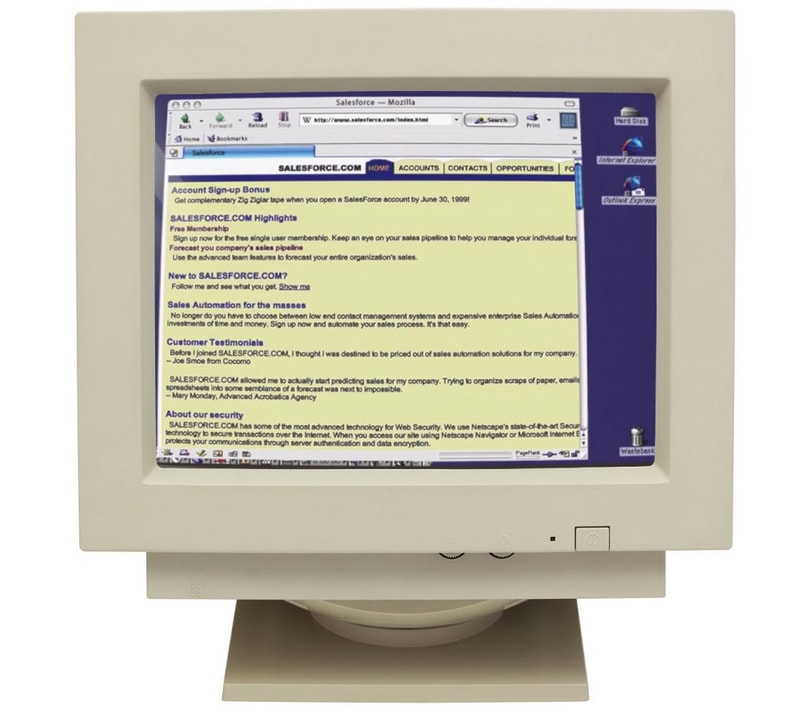
In fact, Marc Benioff used Amazon.com as his inspiration. According to his vision, business applications should be as easy to use as any web page, and the king of usability at that time was Amazon.
The first customers came from that first version, and it was thanks to that that in July 1999 Marc was able to devote himself in time to the Salesforce.com project. His first task was to find an office that was suitable for his needs, and by November 1999 the company had 10 employees and new offices in Rincon Center.
The 2000 Revolution: No Software
The launch took place at the Regency Theater and was truly amazing. They put on a performance where they adapted the theater’s stage as if it were a software company’s office, a stage with a hellish, chaotic look: screaming salespeople, caged employees, and people looking to escape that hell by breaking through to the surface, climbing up to find Salesforce.com. Attendees were impressed, and Salesforce made the impact it needed to stand out.
Accompanying this event was a brand campaign with a curious negative slogan that would become the Salesforce benchmark for many years, “No Software”.
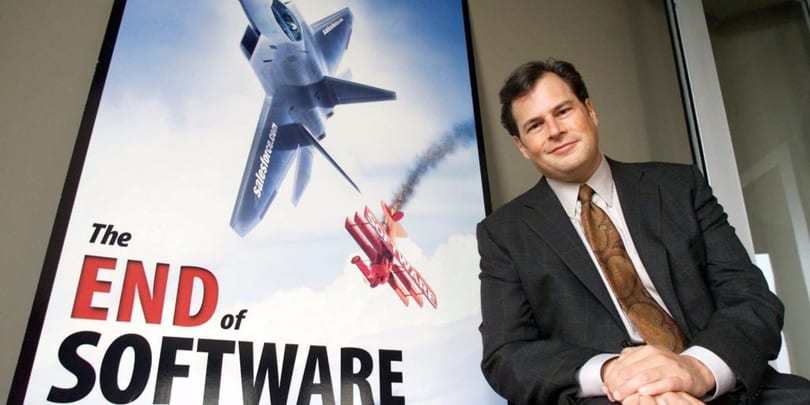
The launch took place at the Regency Theater and was truly amazing. They put on a performance where they adapted the theater’s stage as if it were a software company’s office, a stage with a hellish, chaotic look: screaming salespeople, caged employees, and people looking to escape that hell by breaking through to the surface.
Climbing up to find Salesforce.com. Attendees were impressed, and Salesforce made the impact it needed to stand out.
Accompanying this event was a brand campaign with a curious negative slogan that would become the Salesforce benchmark for many years, “No Software”.
In 2003 Dreamforce begins
In its early days, Salesforce had held many events around the country called “City Tours”, which usually lasted a few hours and featured the latest features of the tool as well as Salesforce’s road map for the future.
These were also events designed to get customers networking and talking about how to get the most out of Salesforce.
But in 2003, they went for a new, much more ambitious, multi-day event format that they called Dreamforce.
Including the Ohana concept in 2004
In Hawaiian culture, Ohana represents the idea that families that are united (by blood, adoption or relationship) each member is responsible for the rest of the family members. And when he created Salesforce in the year 1999, Marc made sure that “Ohana” was at the heart of the company.
In 2004, the company hosted its inaugural Hawaiian-themed event, emphasizing its core values and uniting customers, employees, partners, stakeholders, and enthusiasts.
In 2005 the AppExchange arrived
In 2005 Salesforce developed a service that would change business software forever, BusinessWeek called it “The eBay for business software” and Forbes compared it to iTunes. The name chosen by Salesforce was the AppExchange.
The key to the AppExchange is the mix of community and business. It gives partners a place to develop their own apps and open them up to all Salesforce customers. An opportunity to broaden the company’s vision and enhance its capabilities and services, building bridges between customers and partners.
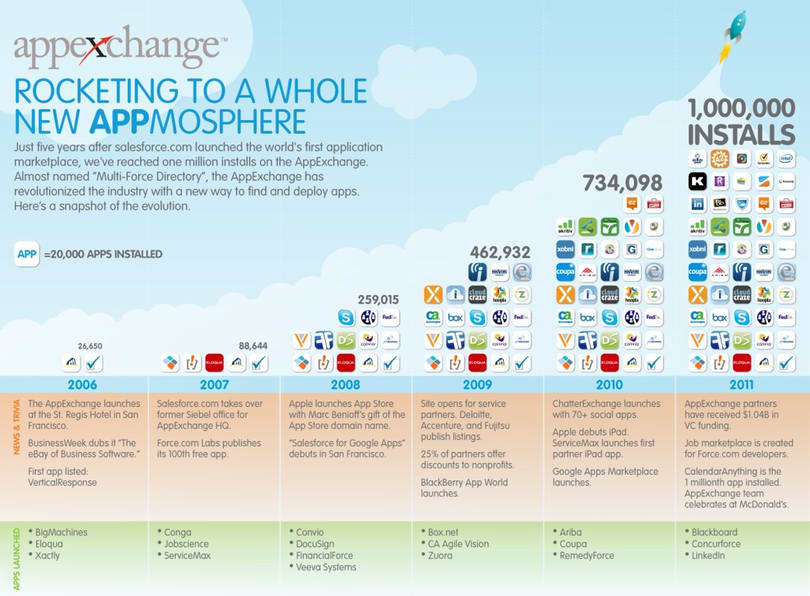
Apex and Visualforce, the revolution of 2006
The 2006 Dreamforce brought together more than 5,000 attendees to learn about Salesforce.com’s latest innovations.
What few expected was what was going to happen there, was the introduction of Apex, Salesforce’s on-demand programming language that allows third parties to write and execute code in a multi-tenant architecture.
This would allow customers, partners, developers, and all stakeholders to operate seamlessly in the same unified language and platform, fostering collaboration and efficiency at all levels.
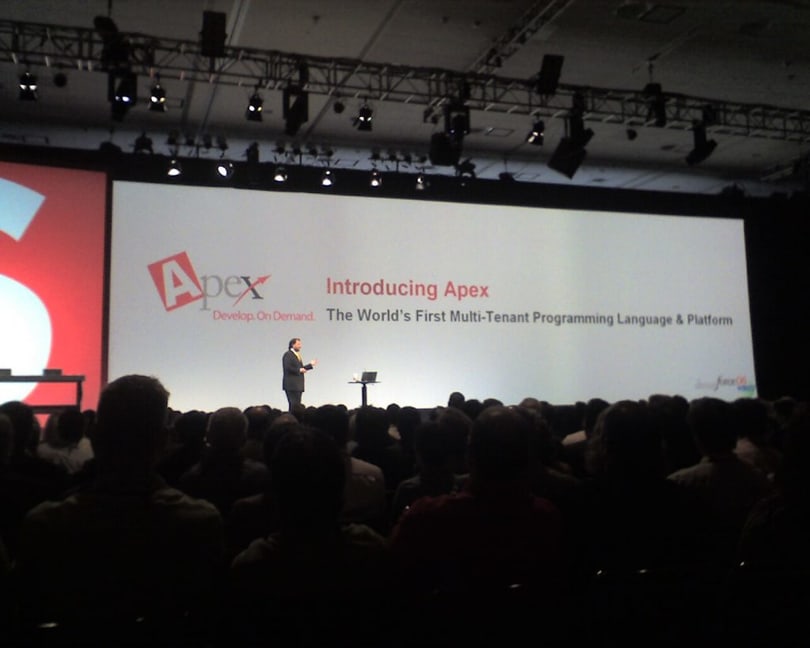
But Salesforce didn’t stop there. Parker Harris developed a technology called Visualforce that allowed companies to customize any user interface, from forms to buttons or links to the ability to embed any custom element.
All of this was integrated into a platform where customers could build their own custom applications. Apex and Visualforce were the beginning of what in the 2008 Dreamforce was called Force.com.
Chatter arrives in 2009, when it gets the first billion U.S. dollars
It is in 2009 that Chatter comes into our lives, announced in this year’s Dreamforce. The Force.com platform incorporated a corporate social network that included the best of Facebook, Google Apps, and Twitter, as well as various integration APIs and mobile applications. 2011 was also the year that Salesforce managed to exceed $1 billion (U.S.), thanks to its 55,000 customers.
Heroku to drive the jump to cloud computing in 2010
Salesforce’s rapid growth allowed Marc Benioff to buy companies at a stroke, while Salesforce needed to expand its cloud capabilities, so in 2010 it bet on the purchase of Heroku for a total of $212 million in cash. A startup offering platform-as-a-service
Forbes 2011 “The world’s most innovative company”
This year begins the famous ranking of the specialized magazine, where until today Salesforce has always been in the top 3, the last one we find it in the Forbes ranking of 2018.
2012 the social revolution: marketing cloud
Already with the Sales and Service clouds as part of the product suite, Salesforce has taken on a new positioning.
The strategic moves that would bring about a change in the company’s cycle have begun.
Multi-million dollar acquisitions took place prior to Dreamforce 2012 such as the acquisitions of companies like Radian 6, acquired for $326 million in 2011, and Buddy Media for $745 million. And a year later, in June 2013, ExactTarget would be acquired for $2.5 billion. In total these three acquisitions reached $3.6 billion and formed the foundation of the Salesforce Marketing Cloud. The social revolution was presented in the Dreamforce 2012 keynote address to 92,000 attendees at the event.
2013 the year of Salesforce 1 and mobility
Salesforce anticipated the importance of smartphones in the industry and started with a mobile application called Salesforce Mobile that was quite limited in terms of access to information and functionality.
It wasn’t until 2013 that Salesforce made the big leap to mobility and introduced Salesforce 1, with the goal of reducing the existing GAP between computer and smartphone It made available to its customers a mobile application capable of displaying all the data and most of the Salesforce functionality on any smartphone A revolutionary application that to date many competing technologies have not yet been able to implement. To be honest, the first years of Salesforce 1 were quite complicated, as the loading speed was quite slow and errors were frequent. Today, the mobile application is no longer called Salesforce 1, as it is entirely built on top of Lightning.
2014 the year of the Customer Success Platform
At the 2014 Dreamforce, Salesforce announces its new positioning, as a Customer Success Platform, thus expanding the positioning of CRM and focusing on a complete digital transformation of companies, facing other major technologies in the world of ERP such as SAP and Microsoft. Unlike these companies, Salesforce opted for a digital transformation process focused on the customer and not on financial processes. To this end, it created the concept of sub-clouds: Sales, Service, Marketing, Communities and Analytics.
It is precisely in the latter (Analytics) that Salesforce invested in 2014. He did not want to be left behind in the new trends of Business Intelligence and Big Data, so in 2013 he acquired the company Edgespring, which was the beginning of the Analytics Cloud. In the Dreamforce of 2014 it became known as Wave and later changed its name to Einstein Analytics, with the arrival of artificial intelligence
Lightning and Trailhead announced in 2015
After 16 years, Salesforce’s appearance had remained a constant that required a profound renovation. Salesforce needed a new look to please its customers. Lightning starts in 2014 and is based on the Salesforce 1 design, but it wasn’t until the 2015 Dreamforce that it was officially launched, along with Thunder and the IOT Cloud.
The Lightning look changed the way Salesforce.com integrates into our browser forever no matter what device we were using. Unfortunately, Salesforce brought an unfinished product to market in 2015 and it was impossible to migrate to Lightning because so much of Classic’s functionality was not developed and it was causing serious performance issues.
Artificial Intelligence and thirteen acquisitions arrive in 2016
The arrival of 2016 also brings new airs of renewal in the company. The technologies related to artificial intelligence were beginning to be a sufficiently mature reality to be able to offer advantages to clients all over the world. Thus, in this year’s Dreamforce, Salesforce announced its new product: Einstein.
Einstein allows all Salesforce customers to access artificial intelligence functionality in a declarative manner.
Einstein’s presentation was received by a crowd of 170,000 people who came to San Francisco for the 4-day conference, in addition to more than 15 million viewers who were able to see every detail of the event via the online webcast.
2016 was the year of acquisitions, a total of 13 of which we highlight:
- Steal Break for a value of $258.2 million. This is currently called Saleforce CPQ and offers advanced Quote to Cash functionality.
- Demandware for $2.8 billion, an e-commerce solution that was renamed Commerce Cloud.
- Quip for $750 million. A project management and document management platform based on a blank canvas on which to work with project management applications.
- Krux for $800 million, one of the leading DMP (Data Management Platform) that would become part of the Marketing Cloud.
An intense year only tarnished by the failed attempt to take over LinkedIn in a bid where another technological giant, Microsoft, managed to make the best offer by taking away from SalesForce the possibility of taking over one of the most important business networks in the world.
2017: The Fourth Industrial Revolution
The incorporation of Internet of Things (IoT) and artificial intelligence (AI) marked a significant turning point in Salesforce’s strategic positioning. It not only complemented the Customer Success Platform concept but also aligned Salesforce with the broader narrative of The Fourth Industrial Revolution.
This strategic shift marked a significant transformation for Salesforce, demonstrating the company’s ambition to expand its footprint within the ever-evolving landscape of business technology. It served as a pivotal moment that highlighted Salesforce’s determination to carve out a more substantial presence in this dynamic industry.
In 2018 move to Salesforce Tower and purchase of Mulesoft and Datorama
In 2018, the time has come to make new strategic acquisitions by the checkbook. First a giant of the same sector, Mulesoft in an operation valued in about 6,500 million dollars. Soon after, another more “modest” acquisition for 800 million dollars, that of the Israeli Datorama, a company positioned in marketing intelligence.
To understand the importance of the first acquisition, we have to think that until that moment, Mulesoft was considered one of the main platform integration providers. Among its clients were Coca-Cola, Barclays and Unilever. A purchase that covers the entire back office that Salesforce needed to continue competing with the business software giants.
In addition, 2018 is the year Salesforce moves to the tallest skyscraper in San Francisco: Salesforce Tower. Construction began in 2013 and has been surrounded by controversy after detecting certain structural problems but these have finally been resolved.
The beginning of the Blockchain era and the purchase of Tableau in 2019
Currently the use of technologies based on blockchains or Blockchain are successfully extending to corporate environments.
That’s why on May 29, 2019, during the Salesforce DX event, Salesforce made a groundbreaking announcement.
They introduced Salesforce Blockchain, an innovative platform built on blockchain technology, seamlessly integrated with your CRM system. This move demonstrated Salesforce’s commitment to embracing cutting-edge solutions to enhance its offerings within the ever-evolving business technology
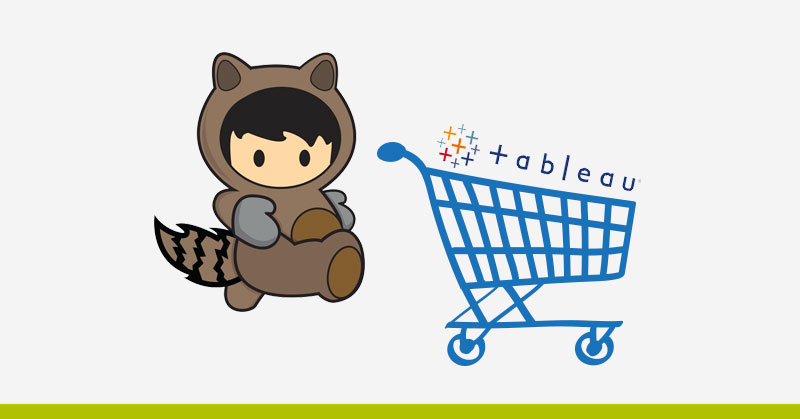
But the big surprise was yet to come. And so on June 11, Salesforce buys Tableau for more than $15 billion, which puts it at the top of the giant of data analytics and CRM.
With this unprecedented move in the history of enterprise software, it brings together both the largest data analytics platform.
It also combines the best CRM solution available. It bringing Tableau’s more than 86,000 business customers to Salesforce. In 2019, it was also decided to merge salesforce.com and salesforce.org, with the former putting up $300 to take over the latter.
This year also saw the release of myTrailhead, an e-learning platform for company employees, a production release that was delayed for more than a year from its first announcement in the 2017 Dreamforce.
What about the future?
In 2018 Marc Benioff “got wet” by making a statement indicating that Salesforce’s goal is to become a $60 billion American company by 2034. Therefore, there is still much history of acquisitions and revolutions to be written. We will be updating this article to keep you informed of the history of Salesforce, a company that in just 20 years has been able to move from a garage to the tallest skyscraper in San Francisco.

